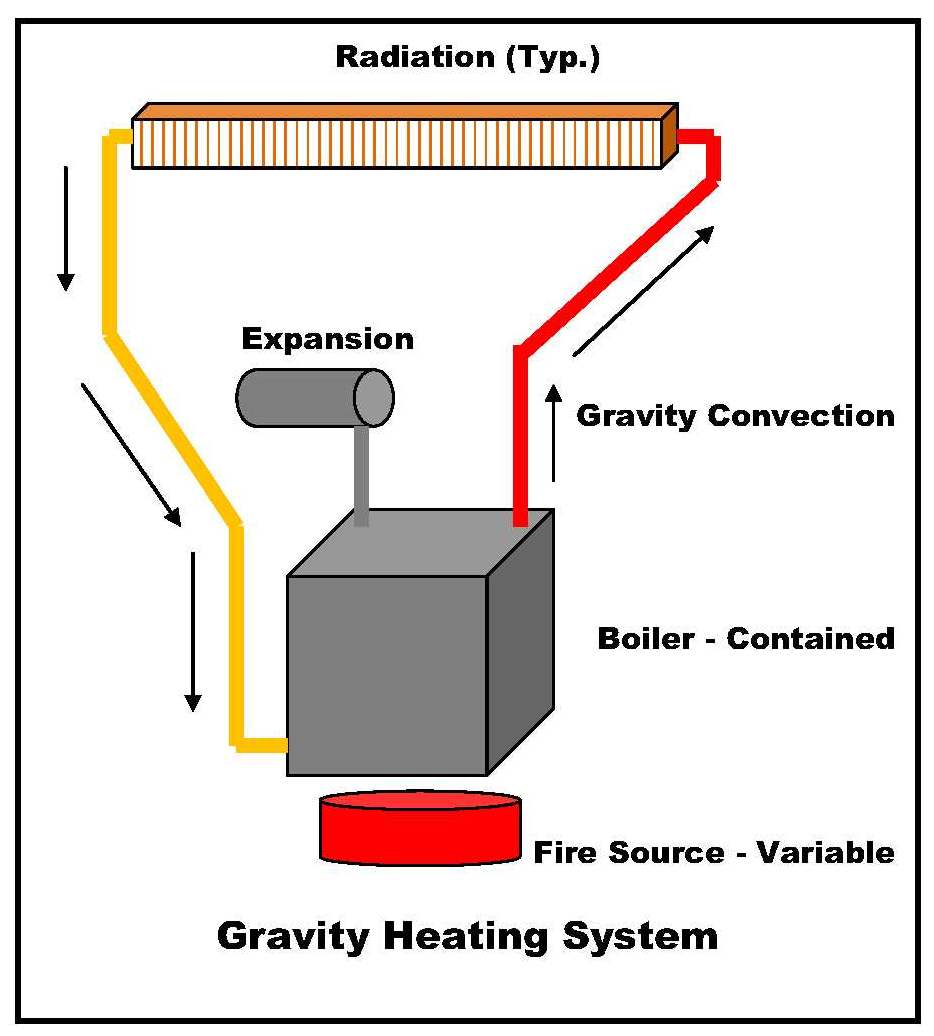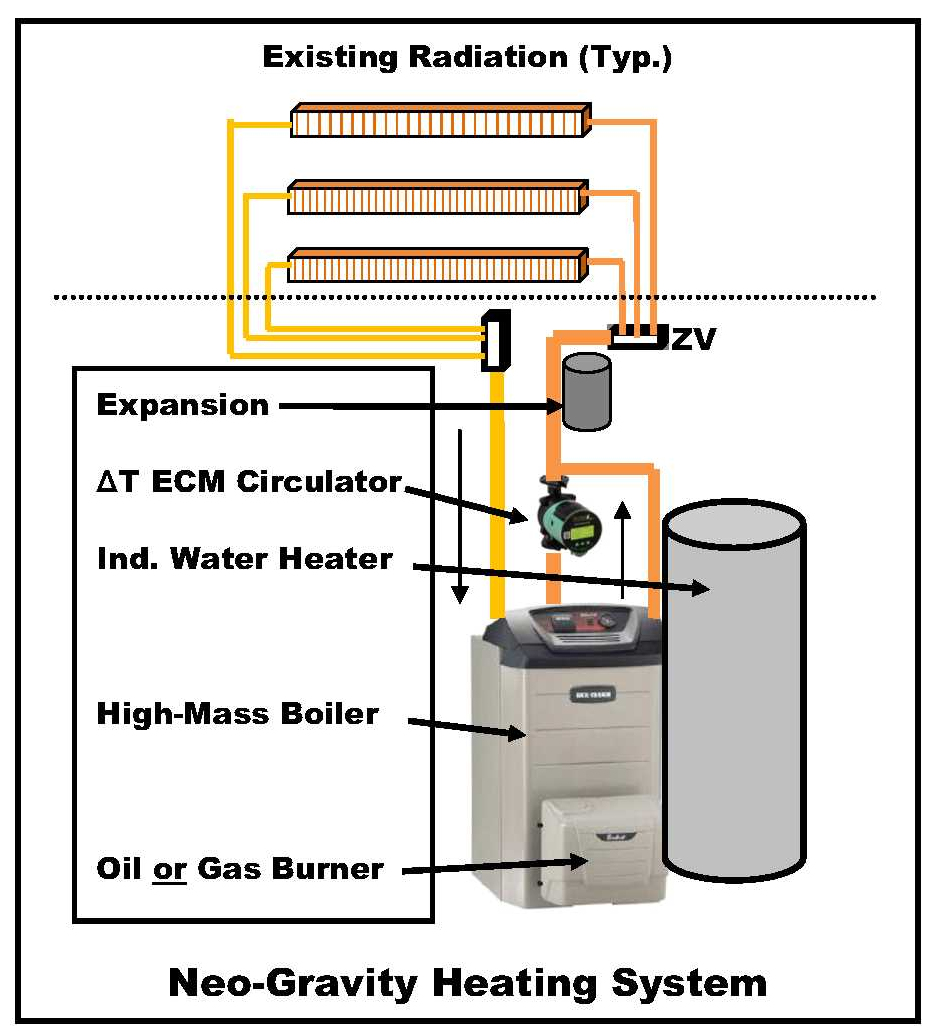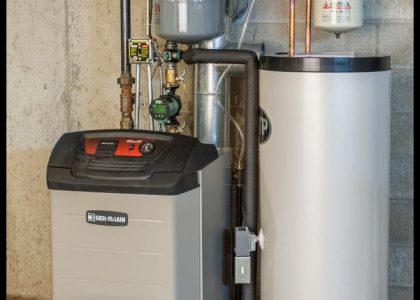What is a Gravity Heating System? A century ago all water-based hydronic heating (hot water and steam) employed the natural gravity convection attributes of heated water and water vapor (steam) to distribute energy. NO DISTRIBUTION ENERGY WAS REQUIRED! They were effectively single-zone systems that could only be modulated by varying the energy input of the boiler and the radiation outputs using register dampers or steam radiator vents, respectively.
Here’s an example: The following photo is of an original-to-the-home Gravity Hot Water Heating System installed in 1890, and still providing perfectly stable and even heating to every corner of this multi-story home. Originally fired with coal, it was converted to oil sometime in the mid 20th century and has had several oil burners installed since. Note the “Control System” comprises an upstairs thermostat, an oil burner and the requisite high limit aquastat strapped to the left gravity riser pipe. That’s it! The owner is currently “considering” a boiler upgrade for obvious fuel efficiency enhancement.

The three (3) basic elements of any hydronic heating system are heat generation (boiler), distribution of energy (circulators) and conversion to area warmth (radiation). Of these hydronic distribution is typically the least understood, generally misapplied and desperately needs revisiting!
The introduction of electric circulation pumps (circulators) in the late 1920’s enabled forced hot water heating (FHW) and changed hydronic distribution forever. Gone were the larger, pitched piping (see example) and radiators, replaced with zoned heating via typically smaller copper piping with finned baseboard radiation. So while natural (gravity) convection underlies all hydronic distribution, its advantage is never considered in contemporary practice. Check-valving is installed to negate its seemingly now undesirable effects. Therefore potentially very beneficial and “free” natural gravity convection is lost.
Early electric circulation pumps (circulators) were large, power consumptive and constructed of discrete components, i.e. motor to coupling to pump. We “old-timers” have vivid memories of failed couplings of varied types, seized and leaking pumps and smoked motors. The advent of wet-rotor circulators was like manna from heaven, reducing circulator issues with greater longevity and reduced power consumption benefits.
The subsequent and more recent introduction of Delta-T ECM Circulators has now projected hydronic distribution management to an entirely new level of sophistication. The embedded control instrumentation features and operational data display of delta-t circulators further provide us with finite attribute identification and sophisticated application control capabilities. Applying this technology to contemporary simple series and split loop perimeter baseboard radiation you emulate that simple and efficient gravity system of a century past.
Thus the focus of our work has been to optimize that innate, suppressed contribution of natural gravity convection as both a distribution energy saver and a selective fail-mode feature in hydronic heating. As such the Taco VT2218 Delta-T ECM Circulator has been the crucial tool in the development of our “Neo-Gravity Delta-T ECM Hydronic (FHW) Heating Appliance™” (USPTO 10,690,356, Canada 2,964,131). We claim optimization of natural gravity convection within our boiler, near-boiler and distribution piping with minimal distribution energy requirements by using a single, dedicated Delta-T ECM Appliance Circulator. Citing an automotive analogy, we refer to it as “putting an Automatic Transmission on a Boiler™”. This intelligent, variable speed circulator is effectively a hydronic CVT (Continuously Variable-Speed Transmission) in practice.
Now let’s go back again to that old gravity hot water heating system of over a century ago. By comparison, contemporary hydronic heating systems have smaller piping with multiple zones for heating flexibility. The old “gravities” employed high-mass cast-iron boilers with larger piping to modulate heating supply, otherwise control was particularly difficult when using solid fuel firing such as with wood or coal. Generous boiler sizing, distribution piping sizes and radiation elements gravity convection worked quite well, and again with NO distribution power requirements!
Properly piping a contemporary FHW system using a dedicated “Delta-T Mode Circulator” with complimentary low-energy ball-type zone valves yields great results! Transposing it onto the old gravity system layout and you functionally emulate its performance as depicted in the following figures.


The major advantage is in applying natural gravity circulation (aka “free energy”) to the contemporary upgrade. We have seemingly lost all other trade skills in managing or enhancing gravity convection. No consideration is ever given to pitching, compacting and minimizing distribution piping in particular to advantage “Mother Nature”. Additional gains are available in radiation layout by using properly sized and configured perimeter series and/or split radiation loops. Merely using a 45° elbow fitting for example can save 30% of piping and reduce head pressure significantly over a 90° elbow run. All that increased pipe and fitting volume and head pressure reduces the natural gravitational convection effect, not to mention substantially increasing materials, labor and lifetime energy and maintenance operating costs of the system.
Our Delta-T Mode Circulator measures this head effect well via its wattage indicator. All of our single, dedicated system circulator Beta Site Appliance installs (currently up to 3,000 sq. ft. structures) exhibit only 8 to 13 watt distribution power consumption with typical 4 GPM flow upon a 20° delta-t (adjustable) differential attainment. Compare this to 80 watts minimum for each contemporary fixed-speed circulator. When delta-t stabilization is established, you witness circulation wattage steadily decay to half or less as natural convection contributes. We refer to this effect like “paddling your canoe with the current”. Takes a lot less effort ….. and power! Our Delta-T ECM Circulator Appliance reduces typical contemporary system distribution energy requirements by 90% and more!
Taco has recently upgraded its VT2218HY1 Delta-T ECM Circulator to a VT2218HY2 variant, a visible change being the addition of a GPM Indicator on its Display. A new customer queried us stating: “My circulator says I’m heating my house using down to 2 Gallons per Minute (GPM) ….. can’t be right”. Our explanation is simply “it isn’t”. Taco is correlating Flow (GPM) to Delivery (Circulator RPM) within its electronics. Any Hydronic Circulator Volute (Impeller) has by design a high by-pass, being an inline “water paddler” rather than a direct displacement pump, per our prior analogy. Therefore when we employ and enhance gravity convection the circulator can’t process this contributing flow effect. (It was actually 4 to 6 GPM, by the way.)
A secondary effect of delta-t managed gravity convection is radiation heating profile modification, smoothing demand amplitude variation and increasing comfort. Some of the extended fuel savings we observe and the delta-t manufacturer claims seem to be due largely to this radiation profiling effect. Yet another contributor is the lowered system operating temperatures by using a very high mass cast-iron boiler vs. contemporary low-mass units. Burner operation cycles are significantly less frequent than the systems they replace, increasing component lives and lowering maintenance costs. Also the “Three For One Rule” applies, i.e. for every 3 Degrees Reduction in Operating Temperature you Gain One Percent in Operating Efficiency. Thus our over 700# minimum “Iron Beast” of an Appliance built on a Commercially-rated Weil-McLain UO Boiler (weighing 625# minimum) can increase its 87% AFUE value to over 90%(?).
A personal cast-iron boiler observation: This author has never replaced a “cold shot” cracked or magnetite impaired cast-iron boiler in over sixty-five years of hydronic and steam installations! Perhaps a discussion for another day, but have we also “thrown the baby (cast-iron boiler) out with the bath water” to cite the old adage? Our commentary on the recent 2019 Annual Boiler Report would seem to support our contention. Read our “reading between the lines” blog on this report.
Finally, the combination of higher boiler thermal mass with enhanced gravity convection extends selective fail-mode heating continuity substantially. Recently and four years prior our Beta Site #3 experienced a fail-safe circulator interruption. The latter an over-current condition from a voltage surge “fail-safed” its operation. In both instances the condition was not discovered for an estimated 2 to 3 days, despite significant heating demand. Neither living area heating nor indirect DHW generation were affected. Second level heating reduction was eventually noted, as prior. The customer called and we reset the power switch over the phone to resolve. It is also noteworthy that we have had no system related service calls in over seventy (70) aggregated-operating-years and 600,000 operating-hours on our monitored Appliance Beta Sites!
In closing, the contemporary excesses and misapplication of hydronic distribution are very troubling to this author. If tradesmen are promoting their prolific system distribution piping efforts as efficiency measures they are most sorely misdirected and possibly even deceitful. Witnessing customers proudly showcasing excessively installed systems or trade supplier contests for the “prettiest system” installation pictures are particularly disconcerting. Trade practices and hence consumer perceptions need challenging. Are we selling parts and labor ….. or performance?
Perhaps it is time for our engineered “appliance” approach to rein in “The Plumber’s Playground©”. (KISS = Keep It Simple, Stupid?)
Updated 11/08/24 P.D.M., Sr.

